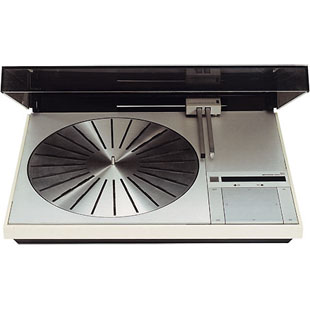Why Linear Tracking Decks?

Why linear decks?
Minimising the distortion
It is really no coincidence that all black vinyl records are cut even to this day on the linear tracking principle. Experience through the years has taught that there is no other way to ensure absolute fidelity and accuracy. Individuals don't have to be 'techno nerds' to appreciate the advantages of linear decks over conventional radial tonearms. Because the stylus sits more comfortably in the grooves, there is less room for tracking error. Which in turn means that there is less risk of sound distortion.
In 1972 with Beogram 4000 Bang & Olufsen used the linear deck principle and developed the world’s first electronically controlled linear, or tangential, tangential record deck. In this pioneering concept, the pick-up moved in a straight line towards the centre of the record parallel with - or tangentially in relation to - the groove. By doing so, the small angular error which would otherwise occur when the pick-up arm moved in an arc on a conventional radial gramophone was removed. Actually the separate arm with its light source and sensor was only used for checking the presence of a record on the platter. This was done by the reflected light being interrupted by the record support ribs of the platter causing a strobed voltage. This strobe would stop the circuit from allowing the pick-up arm from being dropped down onto the platter without a record. It was used to check record sizes as well. The actual drop position was selected and set by a mechanical switch contacts, being allowed when the strobed light source was blocked by the record. Also, when a 7" diameter record was found, the Beogram 4000 would automatically change speed from 33 1/3 rpm to 45 rpm.
The correction for the offset angle of the pick-arm as it followed the record grooves, was controlled from underneath the deck plates, by a metal paddle that had a small slot, attached to the pivot for the tangential pick-up arm. This paddle was sandwiched between a light source above and two photo cells underneath. When it moved inwards it would let some light onto the inner light cell, this causing an error voltage to drive the arm transport motor. Initially the BeoGram 4000s had an outer sensor, where the arm would be driven outwards, in fact it would track a record cut with a spiral groove cut from the centre to the outside. The BeoGram 4002/6000 used more light/sensor circuits with a perspex slide with vertical gratings of various widths to control the arm positioning for auto dropping the pick-up at the lead in edge of the record, and when the arm accelerated at the run out the increased speed would be detected as a higher strobe speed and cause the arm to be lifted and returned to the resting position.
This other, sophisticated mechanical design, the double tone arm, demonstrated the break with the past. By using two arms, it was immediately clear that this was a gramophone which worked in a new and different way. Bang & Olufsen's tangential turntables - Beograms - automatically registered whether the record that you put onto the deck was an LP or a single, and set the speed accordingly - 33 rpm (revolutions per minute) for LPs and 45 rpm for singles.
The special benefit of the tangential arm is that it helped to secure the most authentic reproduction of sound from records because it tracked records in the same way they were cut.
Tangential Drive system
However, the tangential arm was only one of the features that contributed to the achievement of the company's goal. To secure constantly accurate rotary speed a Tangential Drive system was developed. It incorporated a quartz-controlled electronic flywheel, similar to the system used in electricity meters. Like your domestic meter, the system is highly reliable and extremely accurate. It works all day, everyday and never needs repair. You never needed to make corrections in the Beogram's rotary speed. A digital display kept you informed of speed during play. Because the conventional motor was discarded, there were no motor vibrations to distort the sound. A unique pendulum suspension system prevented external shocks and vibrations from affecting sound reproduction.
Optimal sound and minimal record wear
The short, rigid tangential arm was suspended by Bang & Olufsen's patented OPP (Optimal Pivot Point) system which prevented disturbing vibrations from being transmitted to the cartridge.
All in all the tangential Beogram system worked extremely well during the time that they were produced and went a long way in making Bang & Olufsen the world name in innovative technology that it is today.
Created: 9th January 2007
Modified: 7th July 2007


